September has significantly ramped up the North Atlantic storm season, with another major system on the horizon. Category 1 storm Nigel is forecast to become another intense tropical system this week. Given the North Atlantic’s extremely warm sea temperatures, Nigel will intensify rapidly into the 4th major storm of the season over the next two days.
Nigel is expected to become the Atlantic Basin’s next major storm of Category 3 (or greater) over the next few days, thus becoming the fourth storm of the 2023 storm season to intensify to that classification.
This year, the record-high average sea surface temperature resulted in several intense storms; one Category 5 storm (Lee) and two Category 4 systems have already been observed (Franklin and Idalia). So, Nigel will be the next major storm, reaching Category 3 strength this week.
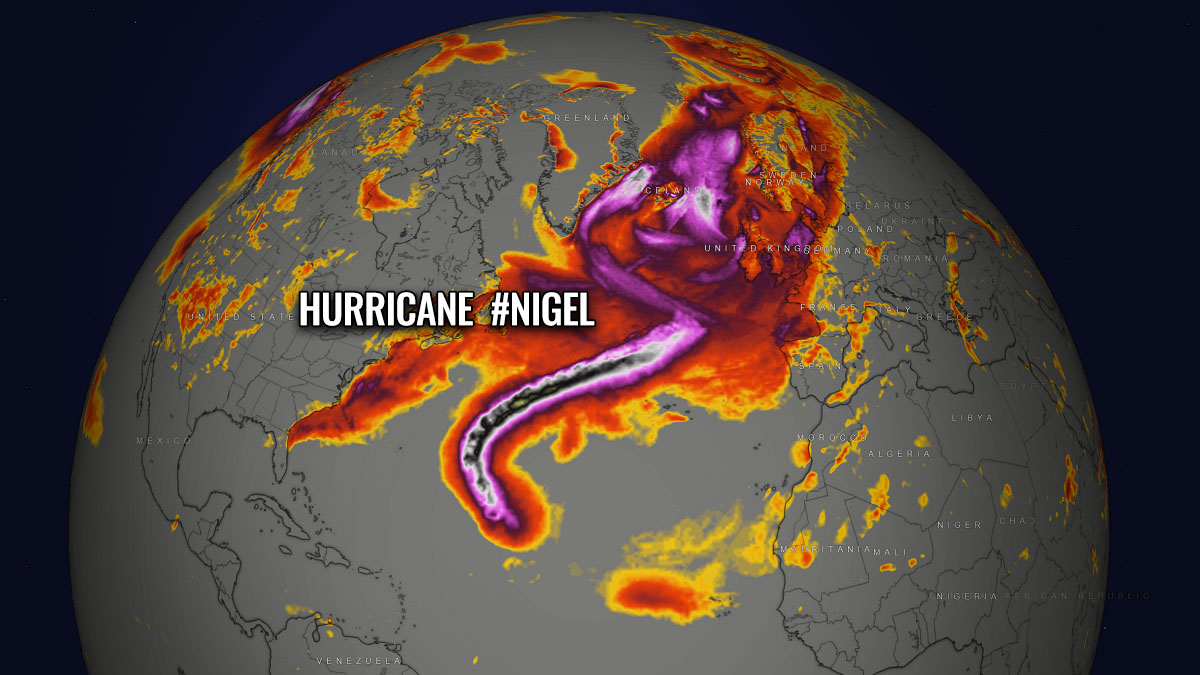
This September’s high activity comes after months of unusually high seawater temperatures in the Atlantic Basin region.
Nigel is forecast to track across the central North Atlantic, first towards the north-northwest, then more north-northeasterly shift is expected. The system will intensify into a major storm and remain powerful until next weekend as it moves toward Europe.

Note that warmer sea waters lead to the highest potential for more tropical systems, including their intensity, during the Atlantic Storm Season, which lasts from June through November. Additionally, given the warm waters, the chances for tropical storms reaching the European continent are also higher than usual this year.
With some help, weaker shear in the upper levels, and multiple waves coming off Western Africa, activity has significantly increased this month. A shallow MJO wave overspread the Atlantic Basin.
WHAT IS THE MJO WAVE?
There are two main ingredients from tropical activity. Besides the very warm oceanic waters fueling the convective storms, there must also be strong upper-level support in place. That is when the atmospheric waves aloft come into the game. The most important atmospheric wave is the MJO wave, the Madden-Julian Oscillation.
First, these are some idealized conditions to learn exactly the MJO wave and why it is a very important ingredient and large-scale feature in tropical regions worldwide. The MJO wave influences the Atlantic Storm Season’s activity significantly. It can suppress the activity and lead to a significant boost in storm development. Here is what happens.
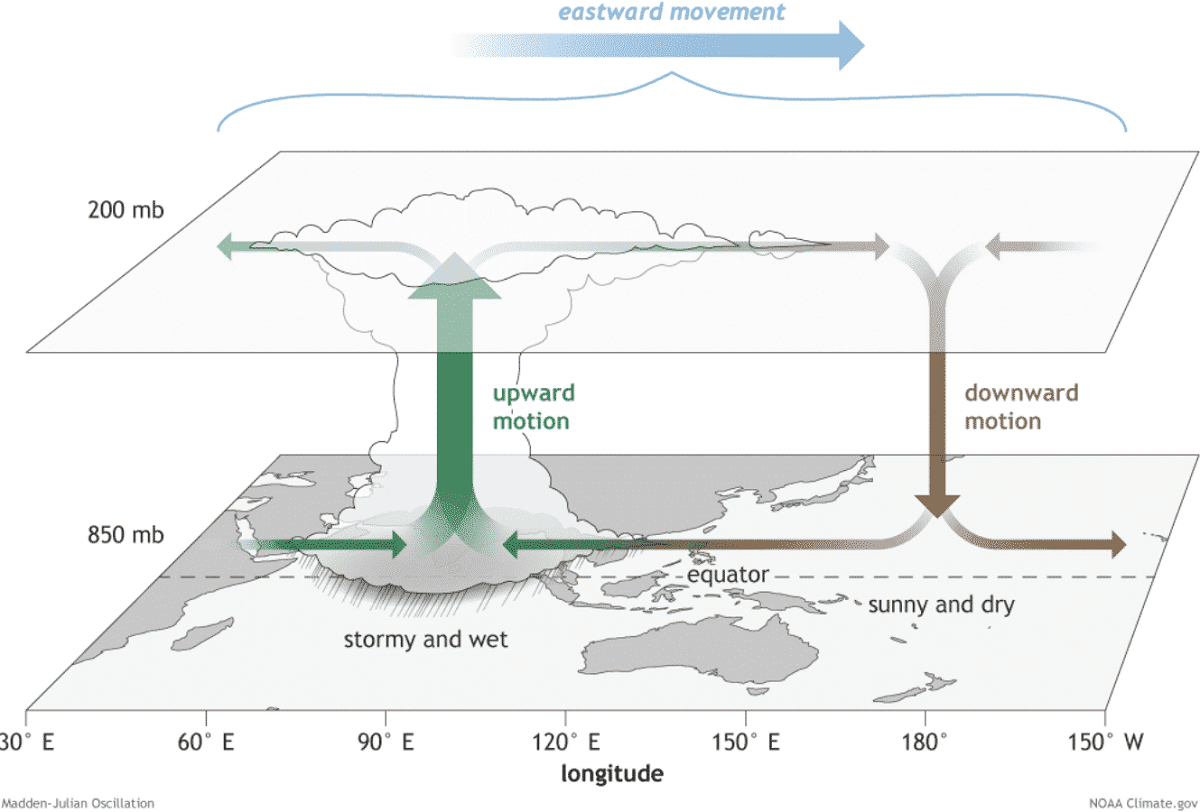
The Atlantic Basin’s western and central parts have general weather dynamics that differ greatly from the mid-latitude regions. Mid-latitude weather has frontal systems with cold and warm fronts, while tropical weather mainly consists of convective activity (thunderstorms).
These thunderstorms occur within very large-scale pressure and wind variabilities, and a lot of the activity in the region is driven by ‘invisible’ waves or wave-like features in the atmosphere. The Madden-Julian Oscillation (MJO wave) is the best example of this. It is known as the largest and most dominant source of short-term activity in the equatorial region around the Earth.
MJO wave is an eastward-moving atmospheric wave, a weather disturbance consisting of showers and thunderstorms. It circles the Earth in the equatorial region in about 30 to 60 days. MJO wave has two parts: the enhanced rainfall (wet phase) that supports a convective development and the suppressed rainfall and convective activity (dry phase) on the other side.
The horizontal movement of these air masses is known as the Velocity Potential (VP). This is a special indicator of the large-scale divergent flow in the upper levels of the atmosphere, which allows the upward motion of the storms – convection.
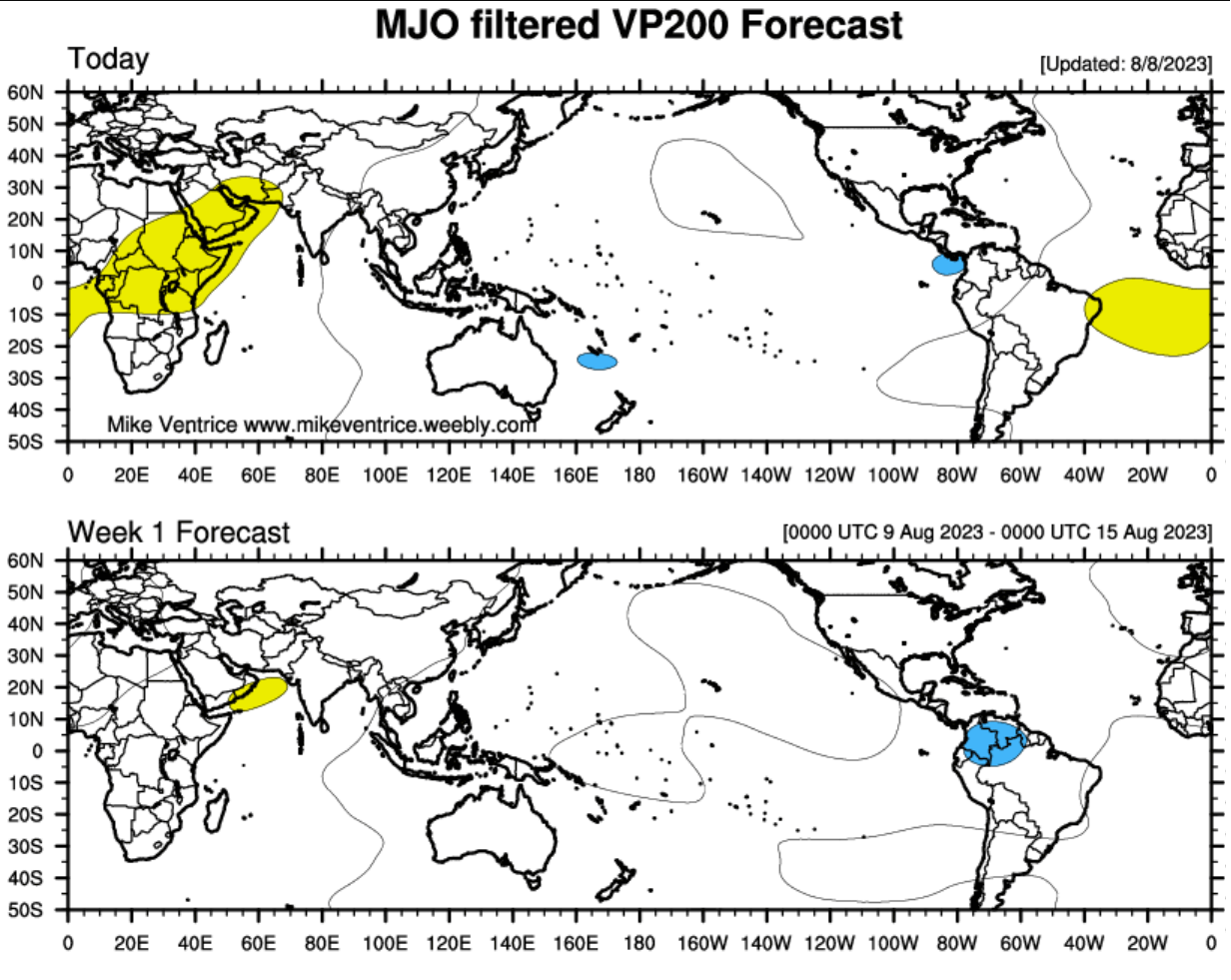
Michael J. Ventrice provided the chart above that indicates a MJO wave (blue tones) emerging in the Caribbean region and western Atlantic. The deeper the wave is, the more supportive conditions normally follow for a few weeks period.
When a region is overspread by these significantly better conditions in the upper levels, the general weather pattern results in a low wind shear environment, which allows a cyclonic system to organize. Often also leads to very rapid or explosive development when the activity moves over the very warm seas underneath.
THE NORTH ATLANTIC BASIN REMAINS EXTREMELY WARM THIS FALL
Back in late July, temperatures at the North Atlantic Ocean surface temperature reached the highest-ever levels in the history of measurements. The daily average temperature of the whole Atlantic Basin was an astonishing 24.9 degrees Celsius (76.8 °F).
Ocean water temperatures are still extremely high this month, from 29 to 32 °C across the western Atlantic Basin. Notice cooler waters around the Bahamas due to the recent upwelling of the water layers from the deeper ocean behind the Lee storm.

With the statistical data, the sea surface temperature in the Atlantic Ocean is generally higher late in the summer. It continues to rise in August towards its usual highest values observed in mid-September every year. The previous record was set last year, in September 2022.
The record value observed in July was even more impressive as the North Atlantic usually reaches its highest temperatures in early September. So, the record was two months before the usual peak values.
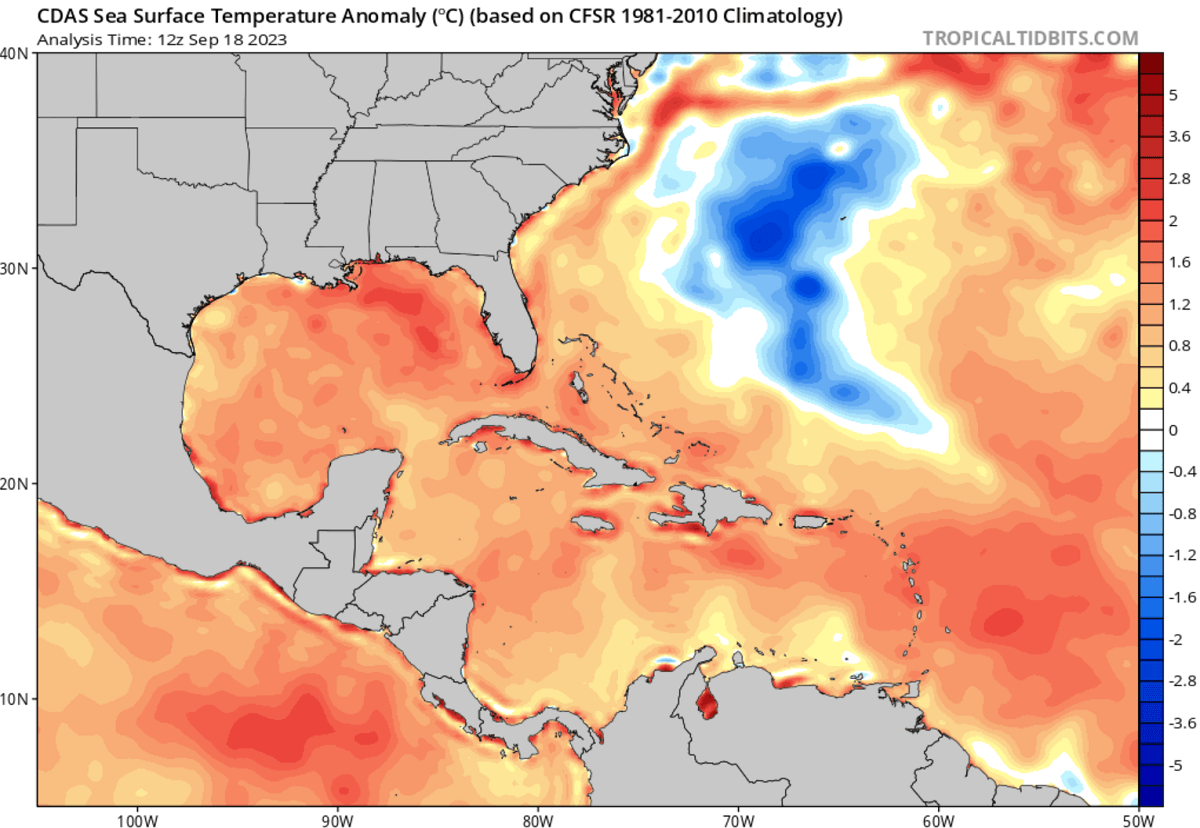
These so-called marine heatwaves are becoming more frequent and intense in recent years. This year, they are more persistent, spread over large areas, and observed worldwide. The 24.9 °C mark in July was more than one degree warmer than a 30-year climatological normal, calculated from 1982 to 2011.
The tropical central and western Atlantic regions remain well above normal as we enter the first month of meteorological fall 2023. The near-term SST anomaly forecast also hints temperatures will continue to rise in the main storm development region.
We expect that these water temperatures of the North Atlantic will be sufficiently warm enough to support significant tropical development during the peak of the storm season that statistically occurs from mid-September through October.
During the summer months, we closely monitor Western Africa’s weather conditions. This is where the tropical waves emerge into the eastern Atlantic Ocean. Data shows that nearly 85% of these waves lead to organized deep convection over the warmer oceans, become depressions, and later get upgraded into storms.
ATLANTIC STORM SEASON 2023 HAS ALREADY HAD 15 EVENTS SO FAR
The 2023 Atlantic storm season has started on June 1st. After mid-August, the activity normally starts increasing, toward the peak in September and October. In 2023, the September activity increase was intense.
The region we monitor these storms is known as the Atlantic basin, which covers the tropical area, including the entire Atlantic Ocean, the Gulf of Mexico, and the Caribbean region.

The WMO’s international committee (the World Meteorological Organization) has designated 21 storm names for the Atlantic season 2023. The list with all the cyclone names can be seen below, starting with Arlene and ending with Whitney.
We use cyclones’ names for one main reason: the warning messages help everyone quickly identify storms in their region.
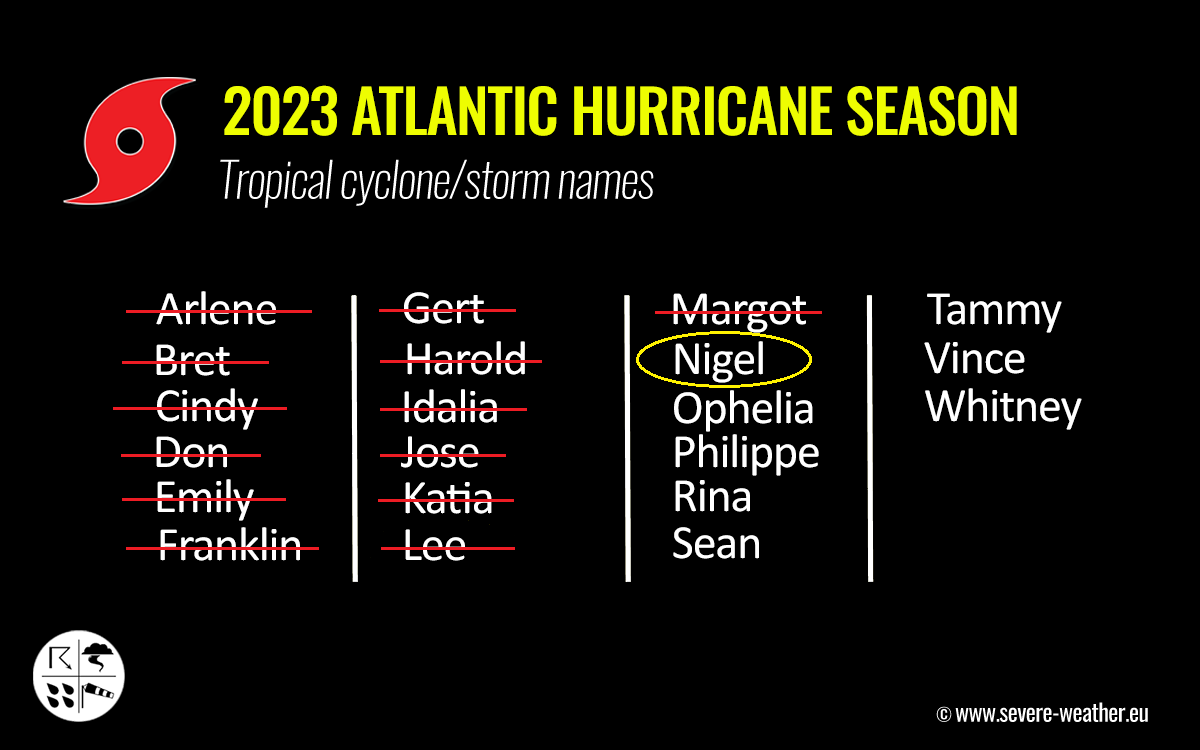
So far, fifteen systems have formed in the first four months of this storm season. There were two Category 1 storms (Don and Margot) and two Category 4 storms, Franklin and Idalia. And the most intense storm of the year, a Category 5 Lee. Nigel is the next.
The long-term average of tropical systems in the Atlantic Basin (taken over the last 70 years – between 1951 and 2020) holds 11 named storms in one full season. At the same time, the short-term average (taken over the last 15 years – between 1995 and 2020) is higher, with around 14 named storms. We can see a gradual increase in the number of storms.
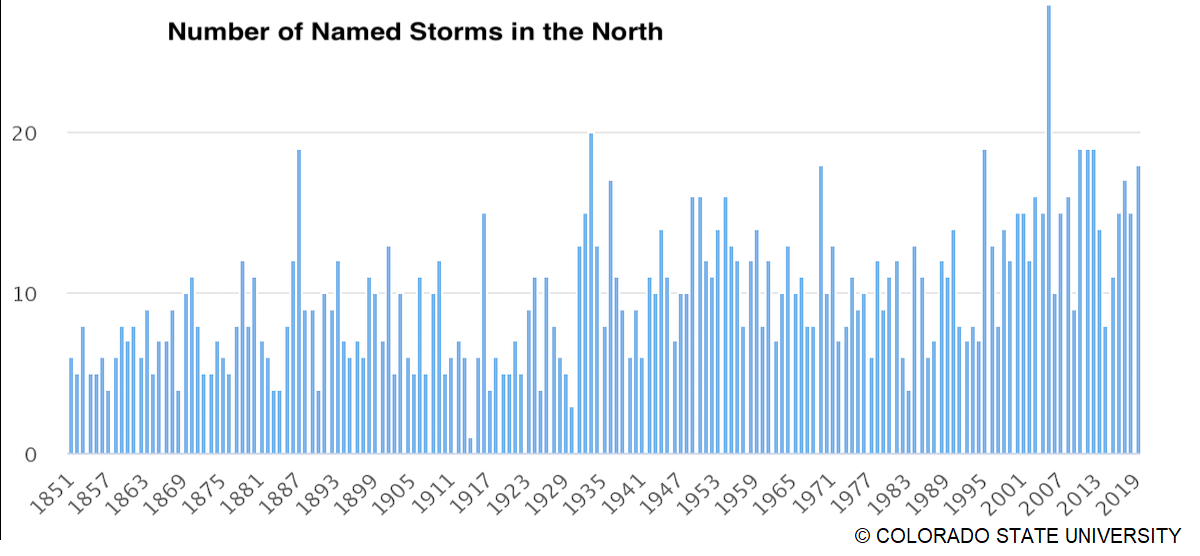
While a La Nina global weather pattern influenced the last three seasons, the 2023 Atlantic storm season is under an El Nino effect. NOAA forecasted its peak in the fall months. El Nino is known to lead to lesser tropical activity due to stronger wind shear in the Atlantic Basin.
However, despite the ongoing El Nino, this year’s well-above-average Atlantic seawater temperatures led the peak season activity into a very busy period. These warmer-than-normal sea temperatures are also observed across the Caribbean and the Gulf of Mexico.
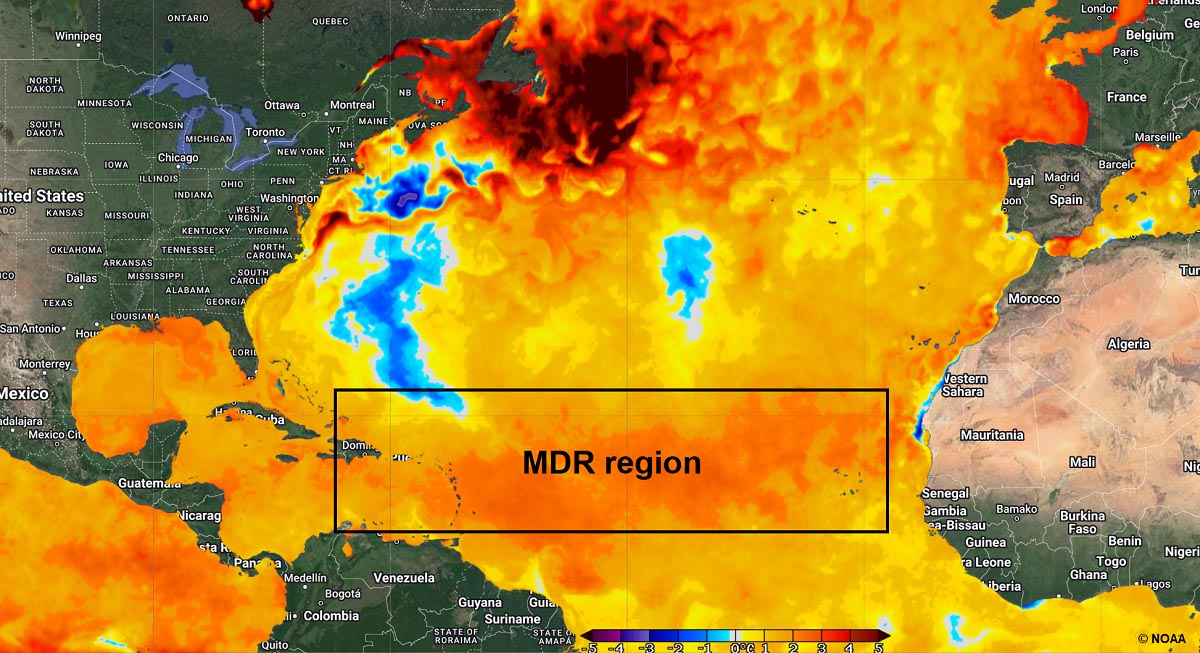
The Atlantic, the Caribbean, and the Gulf are warmer than normal, including across the region known as MDR (the Main Development Region – between Africa and the Caribbean Sea), as seen in the image above. This indicates that upcoming cyclone formation will fuel the warm and hottest-than-ever ocean waters.
A tropical storm organizes and gains its strength when specific weather conditions are met. Normally, we need a low-shear environment with very warm sea waters. The latter results in plenty of very moist air mass above the sea.
NIGEL EXPECTED TO INTENSIFY TOWARD A MAJOR CATEGORY 3 STORM
The geostationary satellite imagery on Monday showed that the convective structure of Nigel has improved. The system is moving northwestward at about 12 kt and gradually strengthening.
The track guidance suggests that the core of Nigel will be moving northwest until Wednesday before a gradual turn towards the north and northeast is forecast.
On Tuesday and Wednesday, a better-organized low-level cyclone structure will strengthen more rapidly as Nigel travels across warm Atlantic seawaters of around 30 °C.
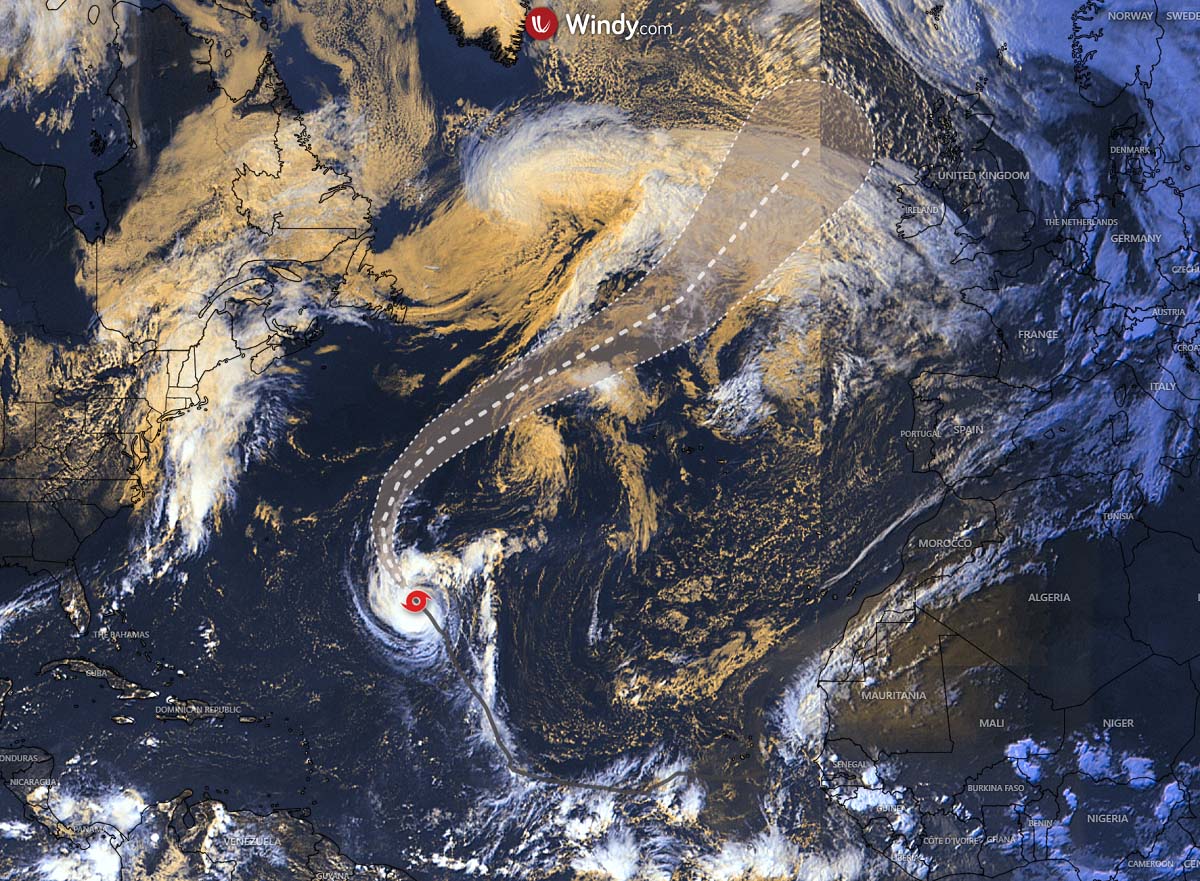
The NHC intensity forecast brings Nigel to a major storm (Category 3 or greater) within 48 hours. It will likely continue strengthening until Wednesday but remain a powerful storm in the days after as it continues across the North Atlantic.
Due to eyewall replacement cycles, some fluctuations in intensity on late Tuesday and Wednesday are possible.
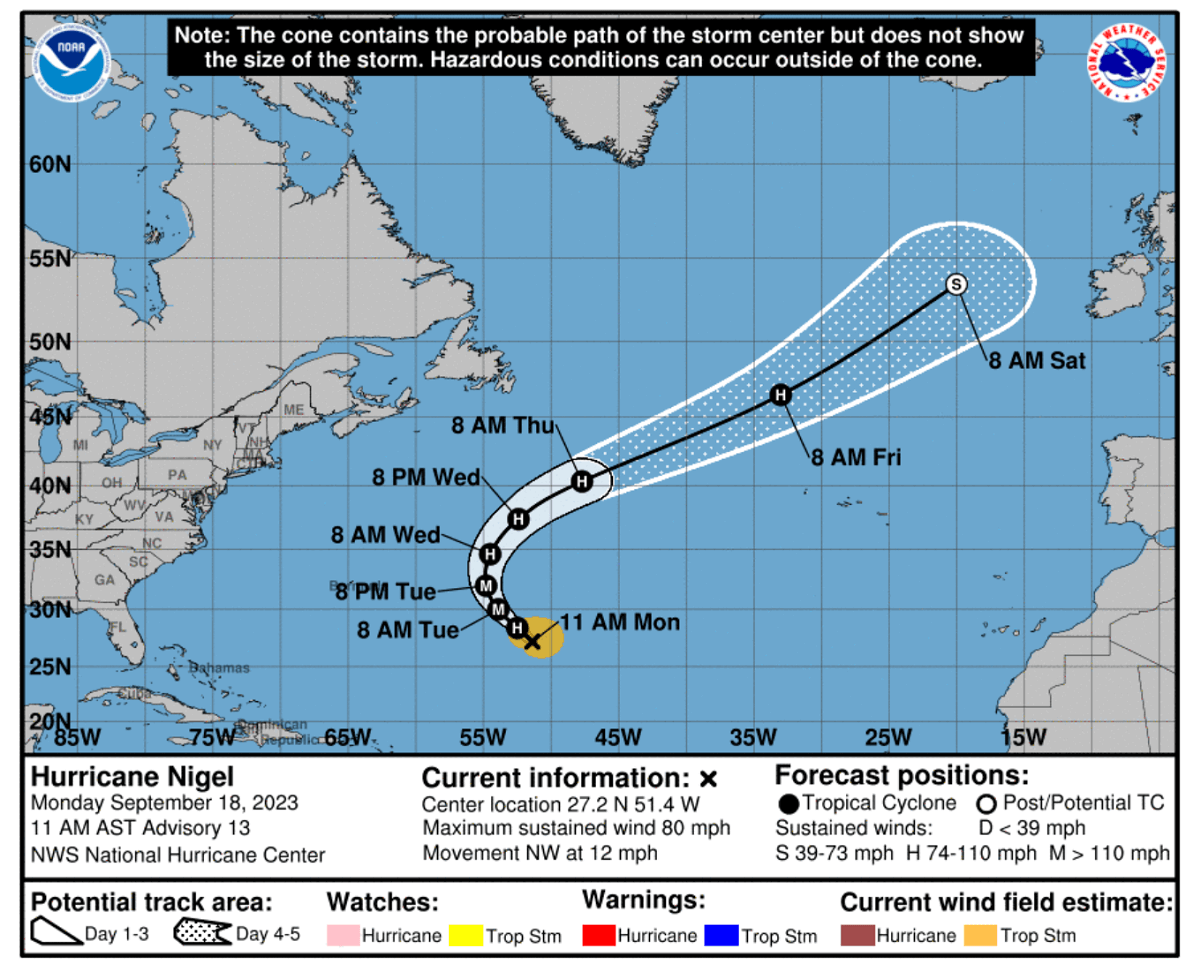
Nigel is forecast to become a major storm by Tuesday night, reaching a Category 3 strength. At that time, it will remain the main threat to ships across the Atlantic, as it will not be near any land areas. Located several hundred miles east-northeast of Bermuda.
The following chart represents Nigel’s peak wind gusts swath over the next ten days. We can see how it becomes a violent storm as it tracks toward the north and northeast in a few days. Peak gusts when it approaches Northwest Atlantic could exceed 130 mph.

Major Storm Nigel is forecast to track more toward the northeast after Thursday but should remain a powerful North Atlantic storm. A transition into a post-tropical cyclone is forecast after Saturday as it nears Europe.
The rainfall accumulation map below also indicates the projected violent storm Nigel to the east of Bermuda, turning northeast with time later this week.

But notice another potential development along the U.S. East Coast, as a swath of excessive rainfall is foreseen from Florida and the Bahamas to Mid-Atlantic states.
RECORD-WARM ATLANTIC COULD FURTHER BOOST FUTURE STORMS AND THEIR INTENSITY
As we discussed earlier above, the extremely high water temperatures across the North Atlantic, including the Main Development Region, have something that has never been observed before. This means that one of the main conditions that fuel tropical cyclones is particularly anomalous – the heat content.
For a tropical storm to form, two meteorological features must be present:
- A weather disturbance, such as a cluster of thunderstorms that pulls in warm surface air (dewpoints) from all directions
- The water at the ocean’s surface has to be at least 79° Fahrenheit (26° Celsius)
Because of the interaction of warm air and seawater that spawns these storms, these cyclones form over the oceans between about 5 and 20 degrees of latitude. At these latitudes, seawater is warm enough to give the storms strength and the rotation of the Earth, which makes them spin.

These systems generally start with evaporating warm seawater, which pumps water into the lower atmosphere. This significantly humid air mass is dragged aloft when converging winds collide and turn upwards.
As air rises to higher altitudes, water vapor condenses into clouds and rain, releasing heat. This warms the surrounding air, causing it to rise with the air far above the sea moving upward—even warmer, moist air spirals in from along the surface to replace it.
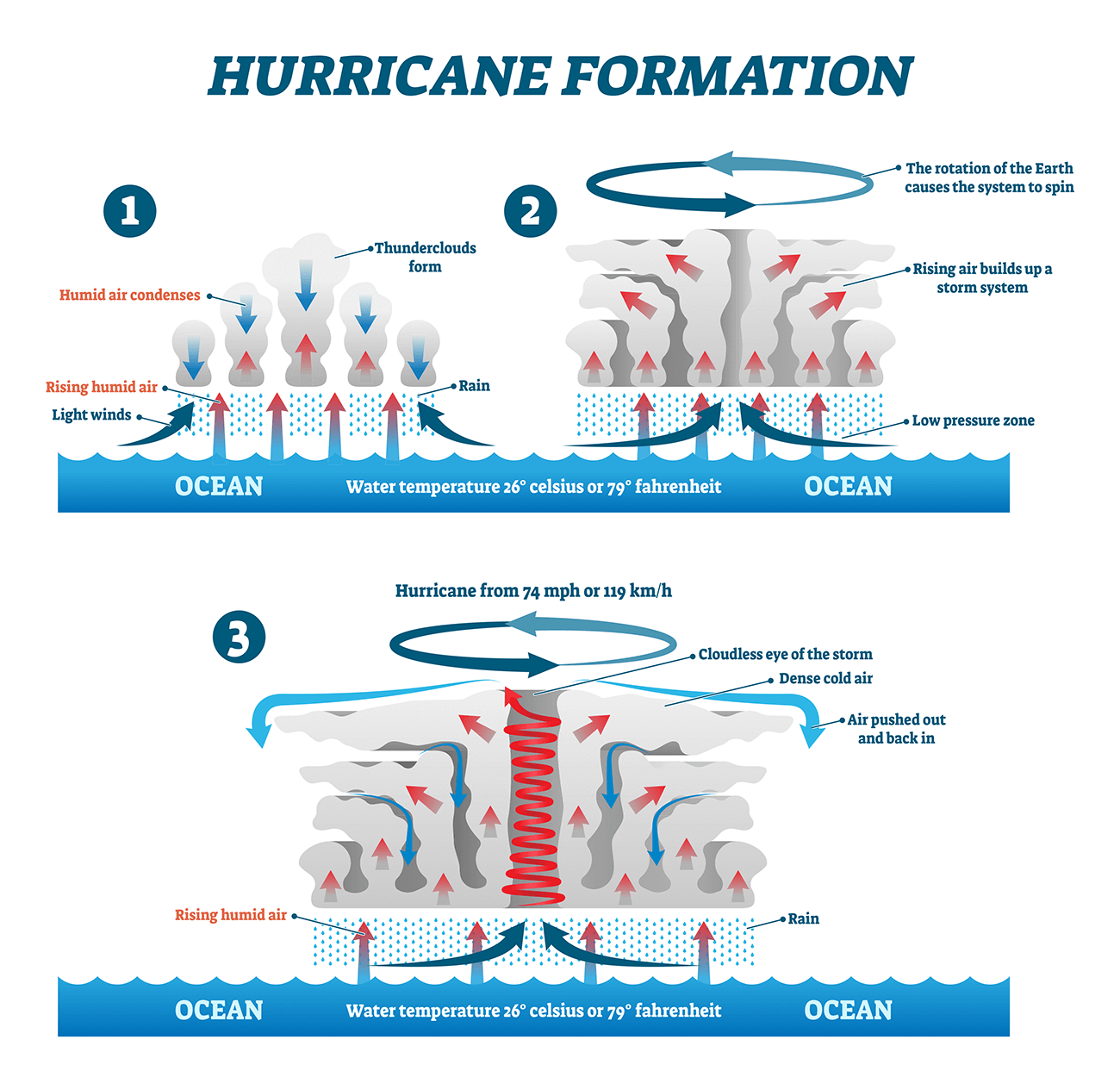
Therefore, as long as the base of this weather system remains over warm water and high-altitude winds do not shear apart its top, the cyclone will be strengthening and growing. This causes even more heat and water to be pumped into the air.
The surface central pressure at its core will drop further, sucking in the wind at ever-increasing speeds. Over several hours to days, the tropical storm (cyclone) will intensify, finally reaching greater strength. A cyclonic system in the North Atlantic officially gets a Category 1 status when the winds that swirl around it reach sustained speeds of 74 miles per hour (64 knots or 119 km/h) or more.

Warmer oceans provide more potential energy for these systems, leading to stronger storms or even more rapid intensification when they grow. Recent studies have shown a link between ocean surface temperatures and tropical storm intensity – The warmer waters lead to more intense storms.
So, as we learned, the two main ingredients tropical systems need for their formation and strengthening are (1) a weather disturbance and (2) warm ocean waters. The latter has been in the record values for the whole North Atlantic.
Seawaters remain extremely warm throughout summer and generally peak in September, the most active period of the Atlantic Season. This increases the chance that the upcoming tropical systems will take advantage of these conditions and support explosive and rapidly developing storms.
SAFETY PREPAREDNESS FOR THE STORM SEASON

Have a plan
The main storm season in the North Atlantic and the Caribbean starts on June 1st and ends on November 30th. This is when you and your family must be prepared by planning.
- Write emergency phone numbers and keep them on the refrigerator or near every phone in your house. Program them into your cell phone as well.
- Prepare an emergency supply kit.
- Locate the nearest shelter in your area and different routes from your home in an emergency. If shelter locations in your area have yet to be identified, learn how to find them before the event of a storm.
- Pet owners: Take care of your pets at pre-identify shelters, a pet-friendly hotel, or an out-of-town friend or relative where you can take your pets in case of an evacuation. Local animal shelters can offer advice on what to do with your pets if you are asked to evacuate your home during a storm.
LEARN THE DIFFERENCE BETWEEN A “WATCH” AND “WARNING”
When you listen to the National Weather Service alerts on TV or radio or check for them online, there are two kinds of alerts:
- A watch means severe conditions (sustained winds of 74 miles per hour [mph] or higher) are possible in a stated area. The NH) will announce watches 48 hours before they expect tropical-storm-force winds (sustained winds of 39 to 73 mph) to start.
- A warning is a more serious threat to deal with. It means violent winds are expected in a stated area. NHC issued these warnings 36 hours before tropical storm-force winds were expected in the area to give people enough time to prepare for the storm.
Check out the NHC for more information about watches and warnings. If you hear a watch or warning in your area, you can take steps to get ready.
GET YOUR CAR READY TO LEAVE HOME IF NEEDED
Make sure your car is ready before the tropical storm hits.
- Fill the gas in your car’s tank.
- Move cars and trucks into your garage or under cover.
- Always keep an emergency kit in your car.

If you don’t own a car, consider making plans with friends and family or call authorities to get a ride if you need to evacuate.
GET YOUR FAMILY AND PETS READY
- Go over your emergency plan with your family; understand everything.
- Keep checking for weather updates about the storm. Watch TV, listen to the radio, or check the NHC website online.
- Call the hospital, public health department, or the police about special needs. If you or a loved one is older or disabled and won’t be able to leave quickly, get their advice on what to do.
- Put pets and farm animals in a safe place.
GET YOUR HOME READY
- Clear your yard to ensure nothing could blow around during the storm and damage your home. Move bikes, lawn furniture, grills, propane tanks, and building materials inside or under the shelter.
- Cover up house windows and doors. Use storm shutters or nail pieces of plywood to the outside window frames to protect your windows. This can help keep you safe from flying debris and pieces of shattered glass.
- Be ready to turn off your power if you see flooding, downed power lines, or you have to leave your home. Switch your power off completely.
- Fill clean water containers with drinking water if you lose your water supply during the storm. You can also fill up your sinks and bathtubs with water for washing.
- Double-check your carbon monoxide (CO) detector’s battery to prevent CO poisoning.
BE READY TO EVACUATE OR STAY AT HOME
During a warning, always listen to authorities regarding whether you should evacuate or stay home.

If a storm is coming, you may hear an order from authorities to evacuate (leave your home). Never ignore an order to evacuate. Sturdy, well-built houses may not hold up against a storm’s power. Staying home to protect your property is not worth risking your family’s health and safety.
There are occasions when you may hear an order to stay at home. If driving conditions are too dangerous, staying home might be safer than leaving. Respect the authorities’ decisions.
If you need to evacuate:
- Grab your emergency supply kit and only take what you need (cell phone, chargers, medicines, identification like a passport or license, and cash).
- Unplug your appliances. If you have enough time, turn off the gas, electricity, and water.
- Follow the roads that emergency workers recommend even if there’s dense traffic expected. Other routes might be blocked or already flooded. Never drive through flooded areas, as cars and other vehicles can be swept away or may stall in just 6 inches of moving water.
- Contact your local emergency management office and ask if they offer accommodations for owners and pets.
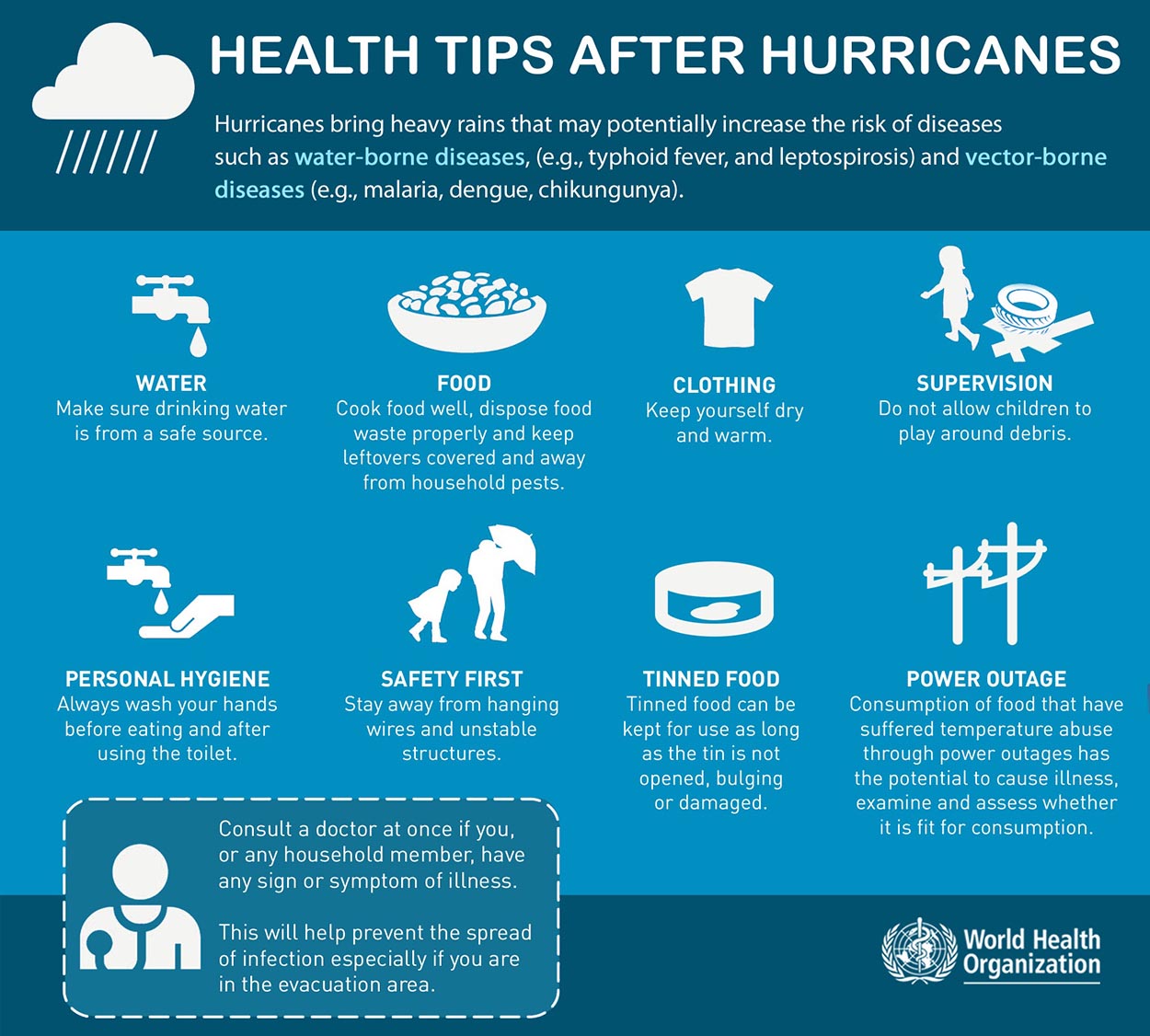
If you need to stay home:
- Keep your emergency supply kit anywhere where you can easily access it anytime.
- Follow weather updates online from NHC, and listen to the radio or TV for updates on the storm.
- Stay inside. Even if it looks calm, don’t go outside. Wait until you hear an official message that the storm is over. Sometimes, the weather gets calm in the middle of a storm but then quickly worsens again.
- Stay away from windows — you could get hurt by flying debris, such as pieces of broken glass or other objects winds pick up around the neighborhood during the storm. Stay in a room with no windows, or go inside a closet.
- Be ready to leave home. If emergency authorities order you to leave or your home is severely damaged, you may need to go to a shelter or a neighbor’s house.
Our expert forecaster team will actively follow the tropical region activity worldwide, including Atlantic Basin systems and tropical cyclones likely to affect the United States, the Caribbean, and Europe again in the following months.
Stay tuned for further follow-up posts, in-depth forecast discussions, and nowcasting during the coming weeks and the upcoming Atlantic storm season 2023 peak weeks. We will make you prepared.
NOAA, NHC, Tropical Tidbits, and WHO provided images used in this article.
See also: